Fatalities in Oil & Gas Extraction – Publications
Publications and Products
Data from the FOG database is used in variety of ways to provide information on preventing worker fatalities in the oil and gas extraction industry. Below is a list of publications and products produced using data from the FOG database.
Special topic data, publications, and products
These datasets, publications, and products describe fatalities identified by FOG that are related to a specific topic.
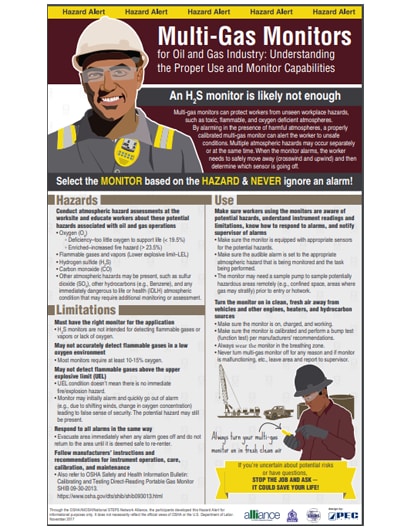
OSHA–National STEPS Network–NIOSH Alliance Product (November 2017)
This infographic hazard alert provides an overview of the proper use of multi-gas monitors in the oil and gas industry.

OSHA–National STEPS Network–NIOSH Alliance Product (June 2017)
This infographic hazard alert provides an overview of how employers and workers can prevent fatalities due to the ignition of vapors by mobile engines and auxiliary motors on oil and gas wellsites.
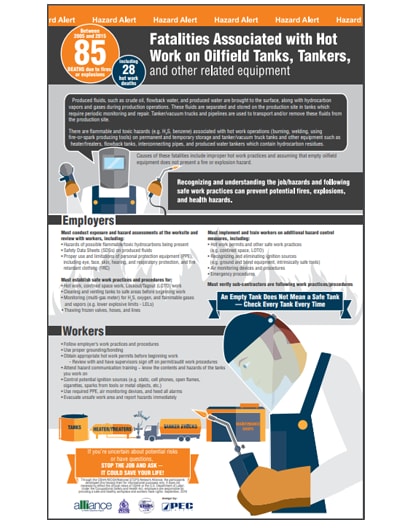
OSHA–National STEPS Network–NIOSH Alliance Product (October 2016)
This infographic hazard alert provides an overview of the hazards associated with hot work on oilfield tanks, tankers, and other related equipment and provides a bullet point list of recommendations to workers and employers to prevent injuries during these activities.
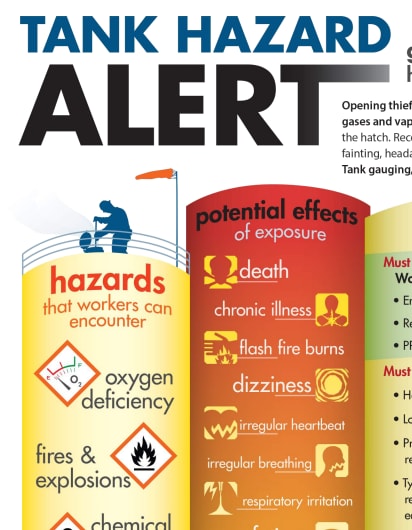
OSHA–National STEPS Network–NIOSH Alliance Product (March 2015)
This infographic hazard alert gives an overview of the hazards associated with opening thief hatches on fluid storage tanks on wellsites and provides a bullet point list of recommendations to employers and workers to prevent exposure.
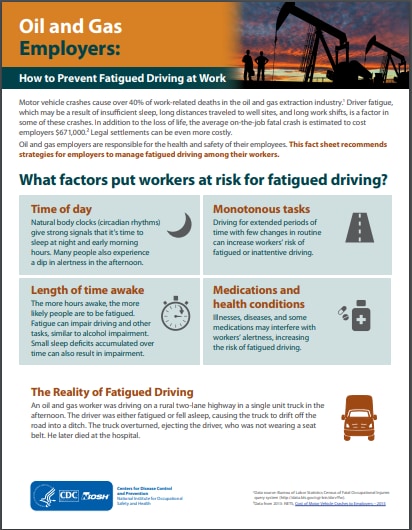
NIOSH Publication No. 2018–125 (March 2018)
Motor vehicle crashes cause over 40% of work-related deaths in the oil and gas extraction industry. Driver fatigue, which may be a result of insufficient sleep, long distances traveled to well sites, and long work shifts, is a factor in some of these crashes. This fact sheet recommends strategies for employers to manage fatigued driving among their workers.
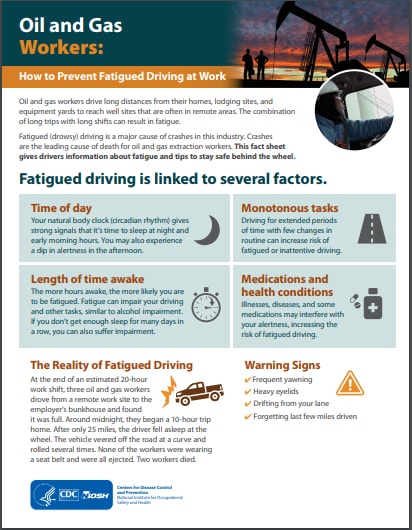
NIOSH Publication No. 2018–126 (March 2018)
Fatigued (drowsy) driving is a major cause of crashes in this industry. Crashes are the leading cause of death for oil and gas extraction workers. This fact sheet gives drivers information about fatigue and tips to stay safe behind the wheel.

NIOSH Science Blog (August 2018)
This science blog describes hazards associated with hazardous gases and vapors during gauging, fluid transfer, and disposal that were identified through surveillance and exposure assessment data. Recommendations are provided for employers, workers, and incident investigators to prevent or limit exposures.
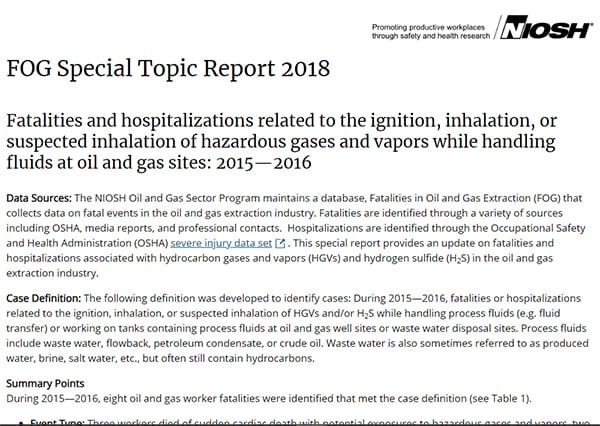
NIOSH Special Topic Report (August 2018)
This report outlines hospitalization and fatality cases, from the OSHA severe injury database and the FOG database, that result from the ignition, inhalation, or suspected inhalation of hazardous gases and vapors while handling fluids at oil and gas sites between 2015 and 2016.

NIOSH Publication No. 2017-158D (August 2017)
This video weaves together a narrative of the health and safety risks involved with manual gauging and fluid sampling on oil and gas production tanks and describes steps that employers and workers can take to do this work safely. In the video, the experiences of oil and gas workers who are responsible for tank gauging and the sampling of crude oil are told from the heart by a truck owner/operator, a company operations superintendent, and the widow of a man who died of sudden cardiac death while gauging.
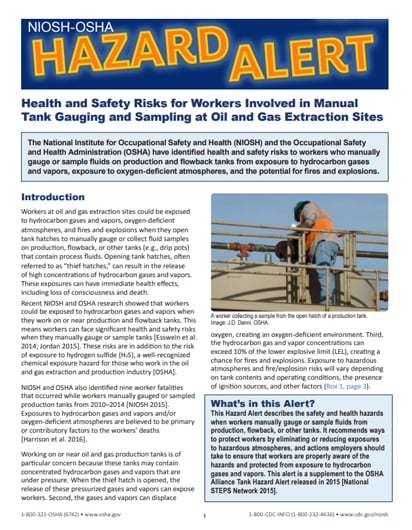
NIOSH Publication No. 2016–108 (February 2016)
This hazard alert produced jointly by NIOSH and OSHA is a thorough review of the health and safety risks for workers involved in manual gauging and sampling at Oil and Gas extraction sites. This document covers the nine identified fatalities related to tank gauging and sampling, as well as exposure assessment data collected by NIOSH and OSHA during these activities. Recommendations on engineering controls, work practices, and personal protective equipment to prevent or limit exposures are provided for employers.
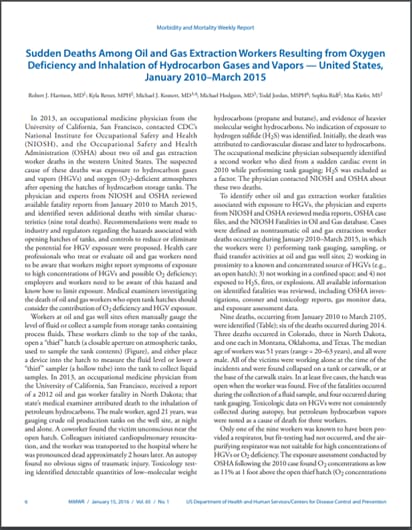
Morbidity and Mortality Weekly 65(1): 6–9 (January 2016)
This article primarily targets healthcare professionals, medical examiners, and coroners to ensure they can take appropriate steps when a worker seeks medical attention presenting symptoms related to exposure to hydrocarbon gases and vapors or dies while tank gauging or sampling fluid storage tanks.
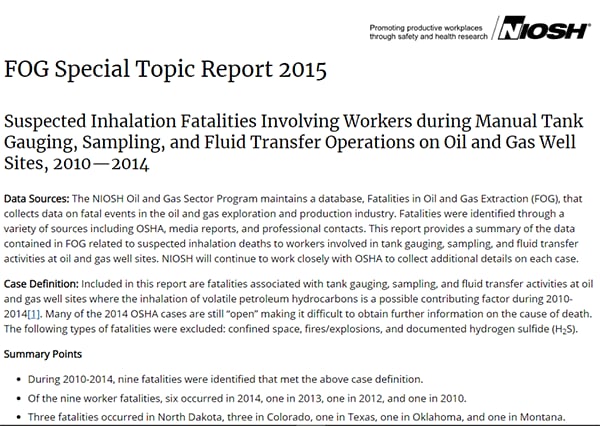
NIOSH Special Topic Report (March 2015)
This seminal report outlines nine identified inhalation fatality cases from the FOG database that occurred between 2010 and 2014. These fatalities were associated with manual tank gauging, sampling, and fluid transfer activities at oil and gas well sites. Inhalation of volatile petroleum hydrocarbons was a possible contributing factor in the fatalities.
Publications and products
These datasets, publications, and products describe fatalities identified by FOG that occurred during a specific period of time.

NIOSH Publication No. 2017–193 (April 2017)
This report provides a detailed analysis of fatalities identified by FOG that occurred in 2014. It is intended to serve as a resource for health and safety professionals, managers, and other stakeholders in identifying and eliminating hazards encountered by workers in the oil and gas extraction industry.
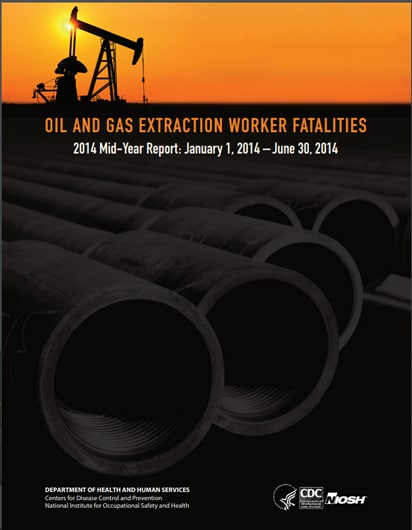
NIOSH Publication No. 2015–239 (September 2015)
The report details fatalities that occurred during the first half of 2014. Information in this report has been superseded by the 2014 Oil and Gas Extraction Fatalities report.
FOG impact and evaluation publications and products
These publications and products describe how FOG is contributing to increasing worker safety and health in the oil and gas extraction industry.
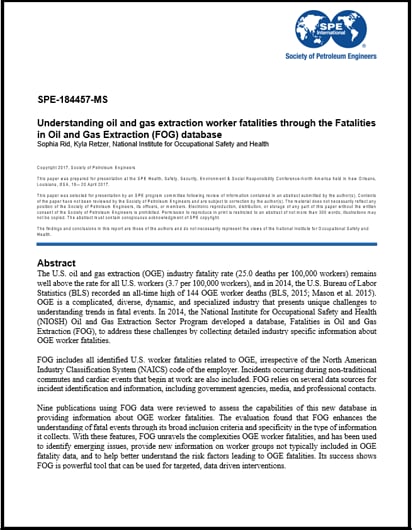
Society of Petroleum Engineers (April 2017)
This conference proceedings paper reviews publications that have used FOG data to assess the ability of the FOG database to provide useful information about oil and gas extraction worker fatalities.
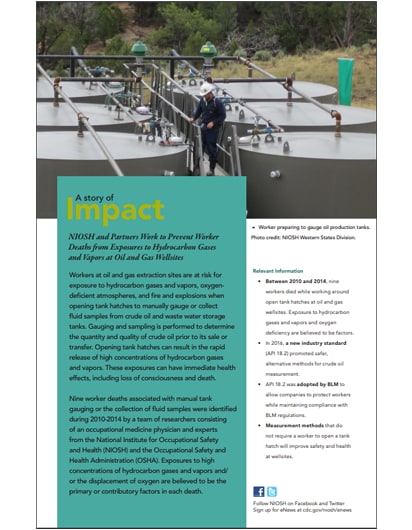
NIOSH Publication No. 2017-110 (November 2016)
This Story of Impact describes how the extensive work to Prevent Worker Deaths from Exposures to Hydrocarbon Gases and Vapors at Oil and Gas wellsites by NIOSH and partners resulted in lasting change.
